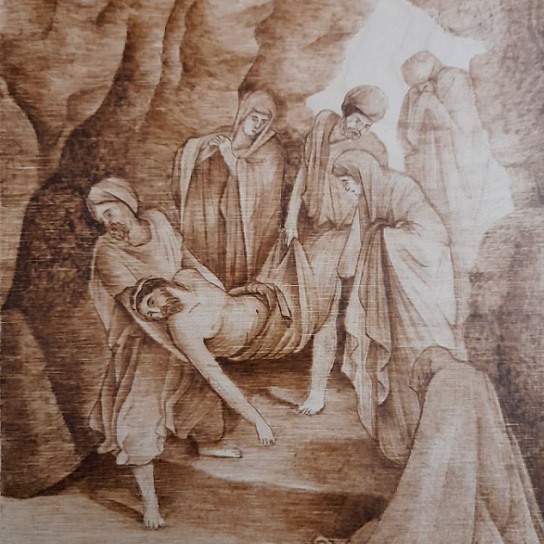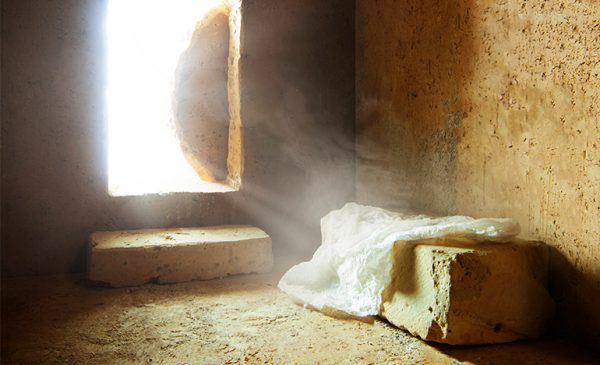The grandeur of Great Friday and Great Saturday lies in the fact that human reason is incapable of comprehending that the Son of God died. In a war, for example, we can evaluate how tragic the situation is by the extent of the destruction. In some way, the same is true here. In order to stop the mighty catastrophe of human history, God died. So that we wouldn’t have a death like that of the animals or plants, so that we’d continue, so that we’d have a resurrection and salvation. In order to prevent our death from being eternal, God died.
But here and now, on earth, how do we live? Sometimes as if Christ had never died and risen.

We often live as though we’re dead, spiritually and in our souls. There are so many pieces and wounds of our souls that we don’t recognize and we often don’t know the roots of our problems. Consciously or unconsciously we bury them, without being concerned about whether this is good or bad. And does this burial lead to resurrection, like a grain of wheat, or to other disturbances? If we thought differently, might we be able to recognize them and take care of them? Naturally, that implies effort, which is a trial of the soul and spirit. But is it a trial for the glory of those suffering it, the way to Golgotha and the Resurrection, or do we just carry it with us through our life? Do we react and forge relationships with others on the basis of what we have buried within us? In this way we see what’s behind our lives. Our discussions and our confessions concerning the problems take place without us having any awareness of the root of those problems. In this way, the root can increase and then it becomes very difficult to remove, and recovery from the wounds it leaves will be long and hard.
If we’re in such a condition, how is it possible for the death of God to touch us? How can we, too, have a resurrection? We all wish each other ‘Have a good Resurrection’. But is there any awareness of the resurrection we’re hoping for? Is it just to leave behind a bad habit? To get out of a difficult situation? Not to sin in the same way again? Each of us experiences the Resurrection personally, depending on the state of our spirit and soul. As was the case with the crowd at the time of Christ, when each person who approached him had something different in mind.
The only way we can find relief from what we’re experiencing is if we decide to follow Christ’s Golgotha, by climbing our own. Because we know that Christ alone experienced this and it’s only in this way that we can stay the course. If we find ourselves on Golgotha without following Christ’s Golgotha, it’ll be difficult, in the first place, to find the endurance needed and, secondly, to experience a resurrection.
On our Golgotha, we’ll need to understand what it is that we’re bearing so that we can crucify it with Christ. We often say that we have a cross, that we’re carrying a cross in our life. All of us know what it means to experience pain, injustice, and many other things that belong to a cross. It may be that our own cross is genuine self-knowledge, because it’s far from easy to see who we really are. Indeed, this self-awareness is often the most difficult Golgotha. Self-knowledge isn’t just the revelation of some bad thoughts. It’s a whole journey during which we acquire an authenticity day by day and we know whether our reactions are a pathological condition we’ve had for years or something else. Are we really in touch with our inner world? Or do we simply live mechanically? Authenticity reflects the kind of congruity we have between our will and actions, between our feelings and thoughts, between ‘I should’ and ‘I want’ or between the Orthodox ethos and way of thinking and social freedom. What agreement do we have between what really represents us and what we’ve adopted without it being something that’s actually true of us? What agreement is there between our faith and the faith of society, between how we appear and how we really are? This path of authenticity is the way of Golgotha and of the Cross. When this genuineness is lost, so is identity, when we’re not as God made us, when we’ve stopped being the wonderful works of his hands and begin to adopt other images, either those of other people or other values which don’t represent us, simply because we want to be accepted. We then become products of a factory, all the same, and uniqueness and personality are lost.
Christ, the authentic God, is the only one who knew what was happening within and outside him. He wasn’t concerned with his own issues, but, firm in his mission, thought only of saving humankind. He was aware of the direction in which he was headed; he knew the cup he would drink. But he put it all to one side and forged ahead, because he wanted the redemptive healing of the human race. Among the great events of Holy Week, we come, at the end, to Nicodemus, on Great Friday. As we know, Nicodemus makes his appearance at the end, as we see in the pyrograph, which is based on an original illustration by the French artist Gustav Doré. At the service of the deposition (the taking down from the cross) we sing with great reverence: ‘How shall I bury you, my God?’. At this service we see the great event we mentioned at the beginning. God died. They would bury him. Here we see the birth of Nicodemus in the Spirit and his own personal resurrection. In the face of the terrible sufferings and events, at the critical hour in the life of Christ, a time when everyone was frightened, Nicodemus came to bury the Lord with his own hands.
He found the courage and took the decision. He was the secret disciple. He used to meet Christ in secret. But at the critical moment, he was the man of God. His genuine love of Christ made him reveal his own truth and his love for the Lord.
In the end, how does all this affect us? Will we, too, have a resurrectional decision that will reveal our own truth? Or have we become so used to something else that any change would require blood, sweat and tears? The resurrection requires authenticity, self-knowledge and the courage to take a decision. These are elements of freedom and real joy, especially when we experience them personally and they’re more than just a nice thought.
Christ knew about his death and accepted it; his death was the fulfilment of his mission. What death do we experience even now? And how can we prepare for the death of our body? Do we agree to bury those mortified parts of us which need to be resurrected? That day would be the day we decided how to live from then on, and on what basis. Or will we stick with the emotionally moving hours and minutes of the services? Will that day give birth to us in the Spirit and Truth, as offspring of the Resurrection, as was the case with Nicodemus?
Christ died in order to bring us out of the tragic situation into which we’d fallen. This was a state of morbidity and total confinement within our ego, which makes us a sealed, ‘whitened’ sepulcher, with any possibility of contact or communication, already defunct, even before we’ve died. This was the tragic state of the Jews and the Pharisees who crucified Christ in the end. And it’s the condition of many of us who, while we condemn it in the wonderful hymns of Great Week, nevertheless follow the path of the Jews and Pharisees. God calls us to the life of the resurrection, not of death, but our fatal condition is reflected in his death. He made us for ‘the abundance of life’, as Saint John the Evangelist says [10, 10], but we restrict ourselves to paucity, to barely surviving. The fall of humankind and our departure from God has made us sick in soul and spirit, which is why we find ourselves in this position. In the times in which we live, terrible events are happening: pandemics, wars, suicides, homicides, isolation, fears, stress, depression and so on. In this dark reality, there seems to be no light. Perhaps we might try to see more clearly into the center of this image and we’ll see that that is precisely where Christ crucified is to be found. That day sums up the whole of human history. Let’s choose to write our own, different history and not leave Christ alone on the cross. Rather, let’s find the courage of Nicodemus, the secret but true disciple. Amen.
From the Skete of Saint Mary Magdalene, we wish everyone a Happy Easter.
The pyrograph illustrations are from the workshop of the Holy Skete of Saint Mary Magdalene in Liti, Langada, Thessaloniki.














